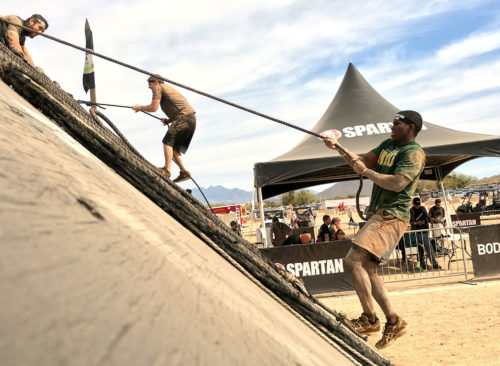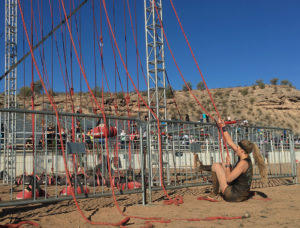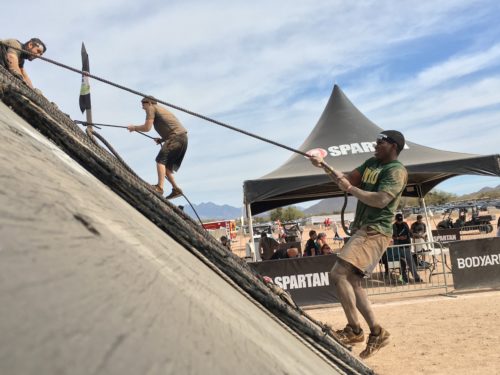
As dawn appears over the Fort McDowell Rodeo Grounds in Phoenix, thousands gather to unleash their inner warrior as they compete in an obstacle course known as the Spartan Race.
According to a Running USA, annual obstacle course race participants surpassed the number of annual participants in marathons and half marathons in 2015. Running USA is non-profit organization created to improve the status and experience of distance running across America.
With similar races such as Warrior Dash, Tough Mudder and American Ninja Warrior, Spartan Race remains one of the leaders in this type of training.
Not just a military-style fitness competition, the Spartan Race is considered more of a lifestyle, mentality and community.
“Being a Spartan goes back to that old warrior mindset of training. Trying to be the hardest, most physically and mentally fit person you can possibly be,” said Christopher Tallant, coordinator of the mountain district for Spartan.
The Spartan lifestyle is considered a back-to-basics approach.

Chris Chavez, a Spartan veteran, has competed in 28 races throughout the country in four years. He considers his first race on Jan. 25, 2014, to be the his most impactful.
“My first race was a life-changing moment,” Chavez said. “At the time, I was unemployed, overweight, and depressed. I really just let life get to me and was in a terrible spot.”
He was fed up with life and wanted to make a change.
“After completing that first race, it had just destroyed me mentally, physically, and in really every single way imaginable. If it was any easier, it wouldn’t have as much of an impact it did on me,” Chavez said. “From that moment on, it lit a fire in me and I try to live to be better than I was the day before.”
In his youth, Chavez was diagnosed with Type 1 Diabetes. Every time he trains, he carries an insulin pump with him.
Since Chavez competed in his first race, he has lost 85 pounds by keeping that Spartan mentality.
But the race isn’t just about losing weight, Tallant said.
“The camaraderie around the Spartan community is something that cannot be put into words,” Tallant said.
Ryan Banda has participated in other obstacle courses over the last two years, but he never tried out a Spartan Race until this year. In fact, the Phoenix race was his second Spartan event in 2018.
“The biggest difference from the other races I have participated in and Spartan is the obstacles are much harder and require more physical strength,” Banda said.

“Other races are more like jumping over a six foot wall or crawling through mud. Where at a Spartan Race, you have obstacles like lifting a 100-pound bag 30 feet in the air and flipping over a 500-pound tire.”
This event attracts both competitive racers such as Eric Scott, who has completed 30 Spartan Races since 2013, and casual racers such as Darryl Vigil, who just completed his first event.
Scott’s friend, a Navy Seal, introduced him to the Spartan races. They started training three days a week, then he showed up to his first race in Temecula, California, in 2013 and finished 23rd out of 5,000 people in the open class.
Scott found the events exhilarating, and a couple of months after his first race, he was competing in Las Vegas, where he finished ninth overall.
“It was the most athletic sport that I have ever done. Everything else was just a singular discipline, whether it was cycling, triathlon, or a marathon,” he said. “This was nice because it encompasses all your athleticism.”
Obstacle course races, especially Spartan, usually attract more males than females. The underlining sociological aspect of this is tied to gender roles, and the need for men to feel masculine, researchers say.
According to an article written by Dr. Michael S. Kimmel, sociology professor at Stony Brook University, masculinity is perception that society has put on men. He said men test themselves to preform heroic feats and take enormous risks in order to have their manhood confirmed by other men.
The down-and-dirty style of the Spartan Race helps fulfill the need for males to be considered “a man’s man.”
Alex DeMarzo is a reporter for Arizona Sonora News, a service from the School of Journalism with the University of Arizona. Contact him at [email protected].
Click here for a slide show of photographs.
“Click here for a word version of this story and high resolution photos.”


